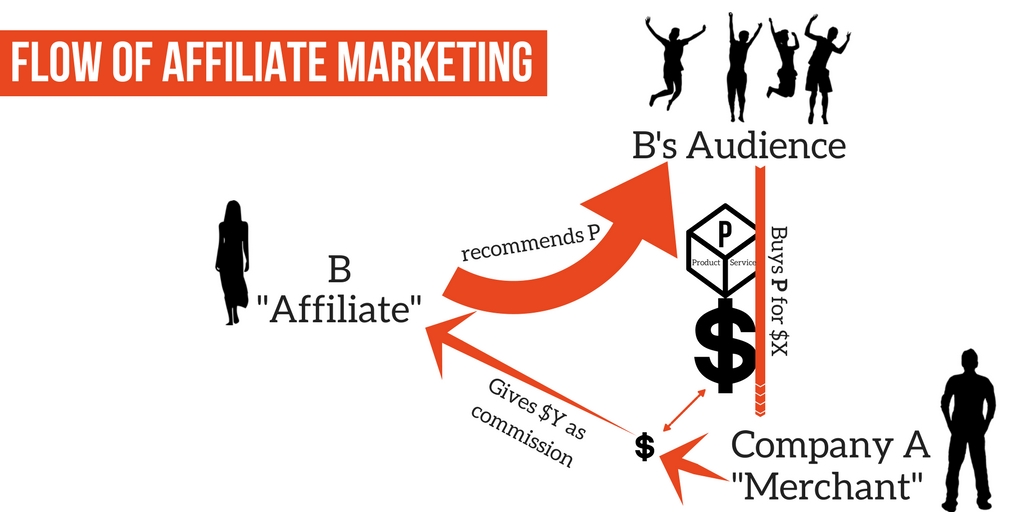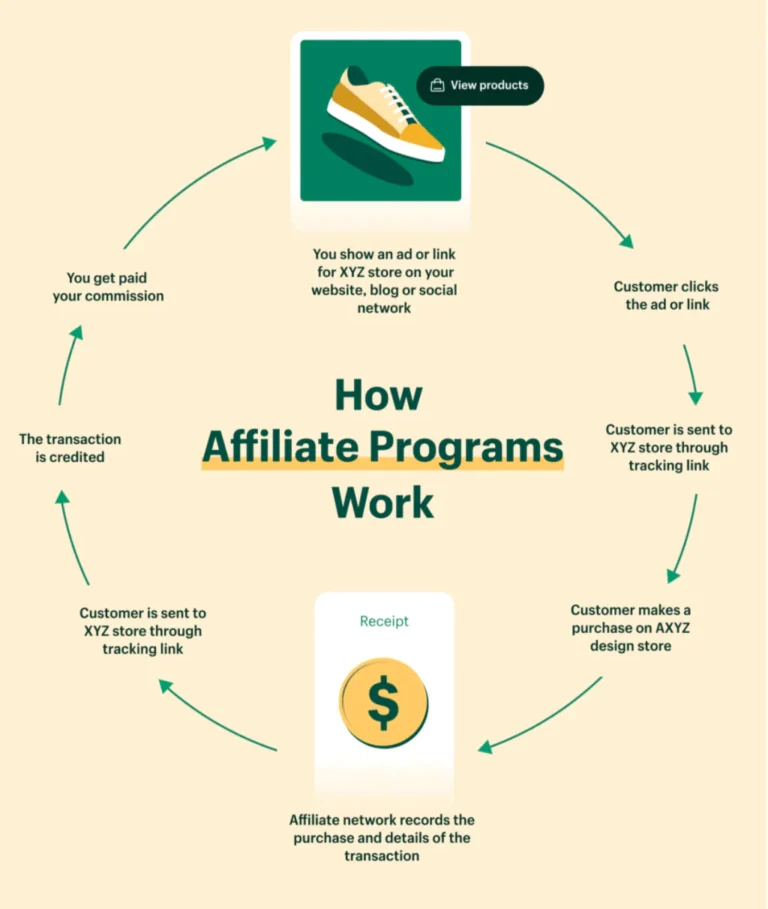Affiliate Marketing: What It Is and How to Get Started – 2024 (Updated)
Affiliate marketing is a marketing model in which third-party publishers promote a merchant’s goods or services and receive a percentage of the sales or web traffic made as a result. It is typically considered a key part of modern digital marketing.
How does affiliate marketing work?
Affiliate marketing involves four main actors, who each play a unique part in the marketing process:
- The affiliate (or “publisher”): The individual or entity that promotes the merchant’s product or service
- The merchant: The individual or entity selling the product or service that the affiliate promotes
- The affiliate network: An intermediary between an affiliate and a merchant’s affiliate program. While affiliates and merchants can connect without an affiliate network, it is a common channel for such relationships.
- The customer: The individual who purchases a product through an affiliate. Merchants partner with affiliates to connect with the affiliate’s audience and convert them into customers.
An affiliate can connect with merchants through affiliate marketing programs. After making some initial connections through a program, the affiliate may be able to find other appropriate merchants and gradually build a wide network of brand partners in a particular industry. For example, an affiliate marketing program might suggest a range of tech products to an affiliate who reviews cell phones. The affiliate can then build a network within this industry and focus on reaching new customers who are interested in tech products.

Occasionally, an affiliate and merchant connect organically through direct outreach. For instance, a merchant who manufactures cake pans might connect with an affiliate who blogs about baking in order to get their product in front of the affiliate’s audience of baking enthusiasts.
Affiliate marketing examples
You likely have seen examples of affiliate marketing before, even if you didn’t realize it. The reason is simple: the most effective affiliate marketing tends to be paired with quality content that readers enjoy and find useful. Although it can be tempting to promote various products to make sales and drive traffic for merchants, affiliates who have developed trust with their audience by highlighting quality products they believe in are more likely to inspire audience members to make a purchase. In other words: quality and relevance sell.
How to start affiliate marketing
Ready to begin your journey? Follow the steps below to streamline the process.
1. Pick your niche.
Affiliate marketers are valuable to merchants because they can reach specific audiences composed of potential customers. The better you define your niche market, the easier it can be to build an affiliate platform and create original content that meets your audience’s needs.
Ideally, the niche you build your affiliate marketing efforts around should relate to your interests and those of a sizeable, underserved audience. As you brainstorm ideas, conduct research with Google Trends to discover what people are searching the internet for that might correlate to your niche topic.
In this exploratory phase, ask yourself the following questions:
- What is a topic, hobby, or field that is of particular interest to me that’s not currently being served?
- What physical products or digital products do I use that I would enjoy promoting to others?
- How can I add a new angle or perspective to a topic with a lot of competition?
- What kind of content would I like to make that would allow me to serve this niche and use my skill set?
2. Pick a marketing channel that matches your niche.
Once you decide on the topic, audience, and products your affiliate marketing brand will cover, you will want to decide on a marketing channel.
While creating a dedicated review website, such as OutdoorGearLab, is a popular approach, you can also do affiliate marketing on social media platforms like Instagram. You may find that one channel is more appropriate for your affiliate marketing goals than others or that a multi-channel or omnichannel marketing approach is best.
Some common approaches and channels include:
- A dedicated product review website specifically oriented around offering readers insights into products.
- A website or blog covering a specific topic that includes links to relevant affiliate products in articles or posts about that topic.
- Social media platforms, such as Facebook, Instagram, Twitter, or YouTube, where you post content related to the products and brands you promote.
3. Join an affiliate marketing network.
Affiliate networks connect affiliates and merchants. While it’s not always necessary to join an affiliate network, you will likely find that doing so will make it easier to build relationships with merchants and ultimately increase your potential to earn affiliate commissions.
The type of affiliate network or marketing program you join will depend on the type of products your audience is interested in. In fact, different types of affiliate marketing programs offer a range of products and services from industry to industry. To optimize your chances of success, research networks and programs that best fit your target product and audience.
4. Expand your network.
Creating a successful affiliate marketing platform takes time and dedication. To increase your overall audience size, though, it is helpful to use a mix of digital marketing approaches, including:
For instance, you might find that a combination of timely email blasts and SEO content will improve your marketing efforts more than either one on its own.
5. Be consistent and master your skills.
In addition to taking time and dedication, affiliate marketing also employs a wide range of skills, including:
- Conducting market research to understand your audience
- Analyzing the competitive landscape to know where you stand among other affiliate marketers in your niche
- Improving writing skills to convey ideas and information through a blog, social media caption, or email blast
- Improving your presentation skills to convey ideas and information through a slide deck, lecture, or live stream
- Improving videography skills to create videos that delight, entertain, and educate your audience
- Learning graphic design to generate attractive graphics related to the products you promote and the message you convey
- Learning data analysis and marketing analytics to understand how your affiliate marketing campaigns perform
- Using software, like customer relationship management (CRM) tools, to keep track of your marketing, sales, and customer experience data
The exact mix of skills you employ in your marketing pursuit will likely depend on the platform you build, the audience you connect with, and the approach you decide to take. For example, if you run a YouTube channel that reviews collectible toys, you will likely need a combination of video production, presentation, and social media marketing skills. However, if you are instead running a website that features only written reviews of collectible toys, then you will likely need to focus on expanding your content marketing skills.
Over time, you might start using all of these skills and more, as you work to drive traffic, produce eye-catching content, and increase affiliate sales.
Watch this video for ideas on how you can design a marketing funnel that helps you reach your audience.
Affiliate marketing tips
As you begin setting up your affiliate marketing business, follow these tips to get the most out of your efforts.
Study affiliate marketing strategies.
Staying abreast of the latest affiliate marketing strategies can enable you to make the most of your time and resources and ultimately earn more affiliate income. Strategies might include offering a webinar on a particular topic and promoting affiliate products during the webinar or building a list of email subscribers.
Consider the rewards you can earn.
When you know what rewards are available to you through different affiliate programs, you can choose which brands can help you reach your affiliate income goals. Be sure to ask potential partners about the commission rate they offer, as well as other rewards for selling products, and factor these details into your overall affiliate strategy.
Build an affiliate dashboard.
An affiliate dashboard is a web-based interface that an affiliate partner or program provides so that you can see how your campaigns perform, generate referral links, monitor your earnings and payouts, and more. When setting up affiliate marketing partnerships with brands, be sure to ask about the dashboard they provide and the information you can track.
Cultivate strong relationships.
Given that affiliate marketing is all about relationships, you’ll want to take action to strengthen the relationships you have with your audience and the brands you promote. You can do this by staying up-to-date on the brands’ latest developments, products, and initiatives so that can communicate accurate information to your audience.




